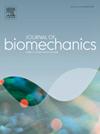Three-dimensional continuous muscle moment arm maps for the anatomical shoulder
IF 2.4
3区 医学
Q3 BIOPHYSICS
引用次数: 0
Abstract
A muscle’s moment arm represents its mechanical advantage and indicates its role in joint actuation and rotational stability. The objective of this study was to use an ex-vivo simulator to map the moment arms of eight major shoulder muscles across a continuous range of motion. The three-dimensional moment arms for the deltoid (anterior, lateral, and posterior), subscapularis (inferior and superior), supraspinatus, infraspinatus, and teres minor were measured in eight specimens (57 ± 6 years) using the tendon excursion method. The anterior deltoid had a significantly larger elevation moment arm in anterior planes of elevation (p < 0.001) while the lateral deltoid had a significantly larger elevation moment arm in posterior planes (p < 0.001). The posterior deltoid was an antagonist to elevation with anterior arm orientations (p < 0.001). The supraspinatus had biphasic function; in anterior elevation planes it was a horizontal extensor and internal rotator but was a horizontal flexor and external rotator in posterior planes (p < 0.001). The infraspinatus and superior subscapularis were both arm elevators, but the infraspinatus was an external rotator and horizontal extensor while the superior subscapularis was an internal rotator and horizontal flexor. The inferior subscapularis was a horizontal flexor and internal rotator while the teres minor was an antagonist to elevation, horizontal extensor, and external rotator. Each muscle had a multifaceted function which changed significantly with arm orientation for all muscles except the inferior subscapularis. The muscle moment arms maps created in this study improve current understandings of the three-dimensional function of eight major muscles in the shoulder.
解剖肩部的三维连续肌肉力矩臂图
本文章由计算机程序翻译,如有差异,请以英文原文为准。
求助全文
约1分钟内获得全文
求助全文
来源期刊

Journal of biomechanics
生物-工程:生物医学
CiteScore
5.10
自引率
4.20%
发文量
345
审稿时长
1 months
期刊介绍:
The Journal of Biomechanics publishes reports of original and substantial findings using the principles of mechanics to explore biological problems. Analytical, as well as experimental papers may be submitted, and the journal accepts original articles, surveys and perspective articles (usually by Editorial invitation only), book reviews and letters to the Editor. The criteria for acceptance of manuscripts include excellence, novelty, significance, clarity, conciseness and interest to the readership.
Papers published in the journal may cover a wide range of topics in biomechanics, including, but not limited to:
-Fundamental Topics - Biomechanics of the musculoskeletal, cardiovascular, and respiratory systems, mechanics of hard and soft tissues, biofluid mechanics, mechanics of prostheses and implant-tissue interfaces, mechanics of cells.
-Cardiovascular and Respiratory Biomechanics - Mechanics of blood-flow, air-flow, mechanics of the soft tissues, flow-tissue or flow-prosthesis interactions.
-Cell Biomechanics - Biomechanic analyses of cells, membranes and sub-cellular structures; the relationship of the mechanical environment to cell and tissue response.
-Dental Biomechanics - Design and analysis of dental tissues and prostheses, mechanics of chewing.
-Functional Tissue Engineering - The role of biomechanical factors in engineered tissue replacements and regenerative medicine.
-Injury Biomechanics - Mechanics of impact and trauma, dynamics of man-machine interaction.
-Molecular Biomechanics - Mechanical analyses of biomolecules.
-Orthopedic Biomechanics - Mechanics of fracture and fracture fixation, mechanics of implants and implant fixation, mechanics of bones and joints, wear of natural and artificial joints.
-Rehabilitation Biomechanics - Analyses of gait, mechanics of prosthetics and orthotics.
-Sports Biomechanics - Mechanical analyses of sports performance.
 求助内容:
求助内容: 应助结果提醒方式:
应助结果提醒方式:


